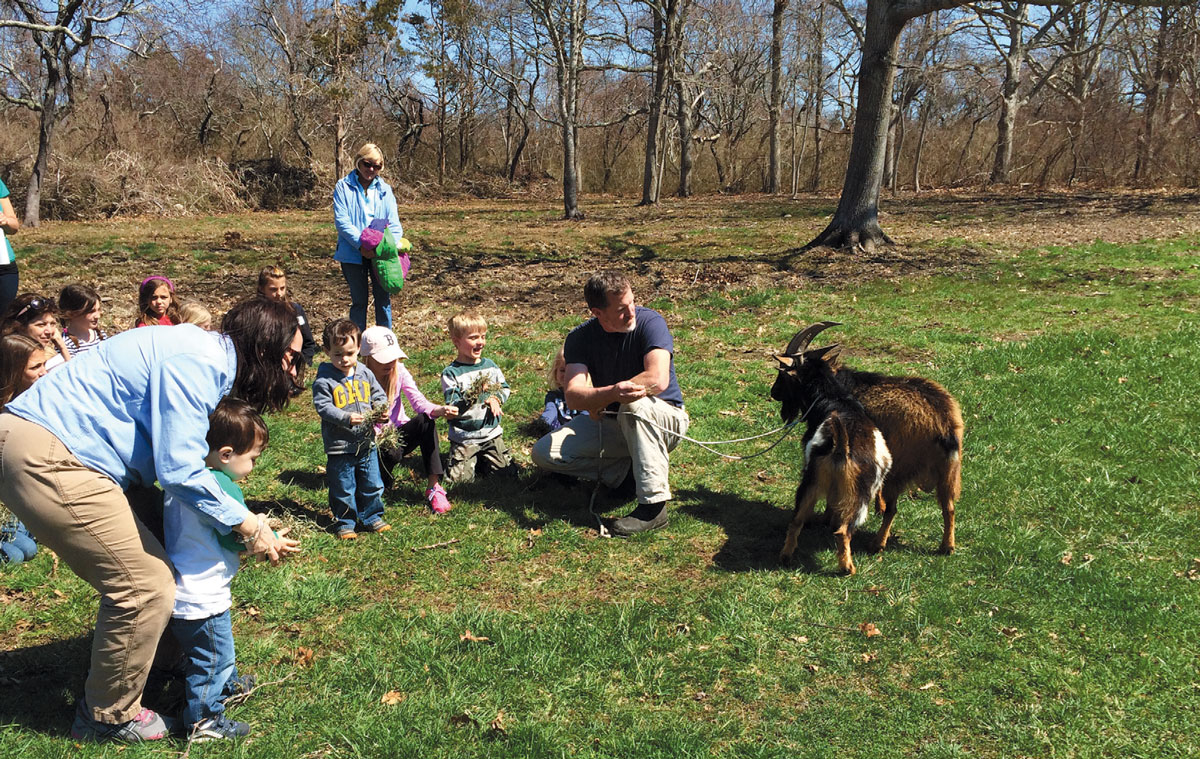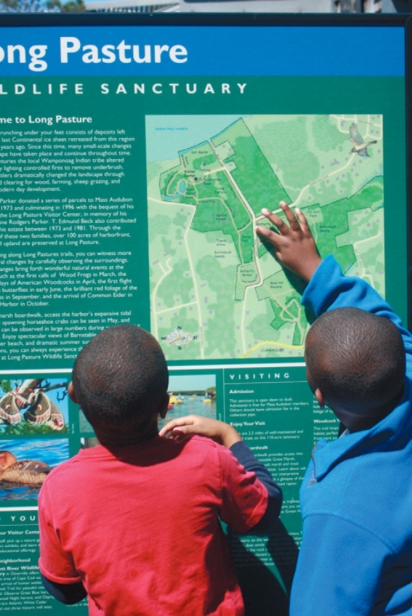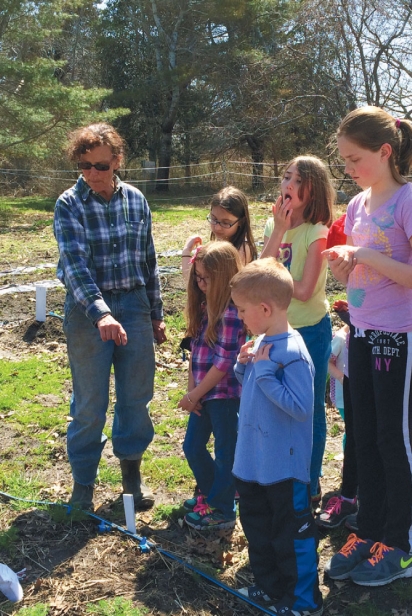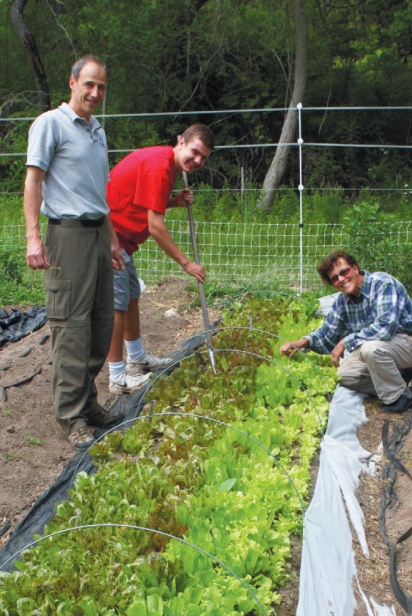The Long Pasture/Farmer Connection
A Successful Agriculture and Conservation Land Partnership
Ancient stone walls line Bone Hill Road in Cummaquid as the narrow way twists and turns through open fields dotted with livestock and adorned with flowers. Here in this pocket of Barnstable, the tall grasses and farmland views offer a glimpse of a long lost Cape Cod, a place of open fields and wide sky and short grass dotted with ruminants. Bone Hill Road leads to Mass Audubon’s Long Pasture Wildlife Sanctuary, where, with thoroughly modern sensibility, farming meets conservation to maintain an ecosystem beneficial to man, beast and verdure.
Cynthia Cole, who has been farming at Long Pasture in collaboration with the Audubon for four years, described the landscape and its importance. “This is a special place. It’s extraordinarily beautiful farmland, with the ocean and the wildlife right here. It has phenomenal soil, and it’s also a community place for the community of Cape Cod, with school busses in the spring, and programs, and workshops for all ages and types of background. It’s a really special resource. Farming is an occupation that youth can stay on the Cape to do. It could keep them here, yet we don’t seem to have any town policies or community interests to foster agriculture. There is land. Conservation groups have bought up the old farms, but they are not being farmed or cared for.”
The partnership between farming and conservation at Long Pasture models how Cape Cod’s remaining open space can be utilized successfully as farmland while maintaining native grasslands, producing local food, and providing local jobs. It also demonstrates how farms can be successfully integrated into local neighborhoods.
The Long Pasture Wildlife Sanctuary sits on 110 acres, which include land and a house bequeathed by former neighborhood resident Sherman Parker by endowment in 1996.
Ian Ives has been Sanctuary Director at Long Pasture since July 2006, and his office is in the Parker’s old house. Over the last nine years he has enjoyed seeing the Long Pasture Sanctuary grow from a little-known property with a trail network to an active community environmental resource.
Ives explains that historically the Bone Hill area, which is part of the sanctuary, was farmland. One explanation of how Bone Hill Road got its name is from the slaughter house that stood there years ago as part of a large farm. To this day, bones are uncovered as people in the area dig their gardens. The farm included cattle and grew corn until it gradually declined. Later the county grazed its dairy herd on the fields. In this case, the farming legacy was obvious and it was not a huge stretch to re-establish agriculture on the site.
Ives said that the new approach to farming is the old approach to farming. This means abandoning heavy, damaging equipment and oversized operations in favor of smaller, old-fashioned, ecologically-balanced efforts.
When the Audubon joins forces with local farmers to achieve both agriculture and land management, both parties agree to a farm plan, which outlines and clarifies farming activities so everyone is on the same page. The plan includes stipulations such as organic practice, number of animals and where the animals will be. The farmers at Long Pasture work independently of Audubon staff and volunteers, and the Audubon/farmer liaison at Long Pasture is part of a wider Audubon initiative. The Mass Audubon sites Moose Hill in Sharon, and Drumlin in Lincoln both have full-blown CSAs.
“Livestock farming returns to the community through sustainable gardening. The farm animals co-exist with the wildlife habitat and ecological management of the sanctuary. We don’t sacrifice one for the other, they co-exist,” said Ives.
“Ian understands the connection and importance of having agriculture with wildlife. He sees the importance of the symbiotic relationship of domestic animals who manage the land and provide the habitat that is quickly disappearing from the Cape. When that disappears, it’s a loss for the Cape in jobs, local food and land stewardship,” said Cole, who is planning to raise up to 200 chickens, Freedom Rangers for their meat and cost effectiveness, on her Audubon plot this year.
“There is a farming legacy here, we didn’t have to inconvenience the neighbors. The precedent was set a long time ago. When we got here there were questions about why we were here, there were concerns that it would get huge and the neighborhood would be exposed, discovered and ruined. There was a lot of apprehension,” said Ives of the Mass Audubon’s early days at Cummaquid’s Long Pasture. “But we want to use the farming legacy to our advantage. A lot of space was under-utilized so why not integrate farming practices that are organic, holistic and sustainable? The practice of sustainable farming is meant to benefit the wildlife and the humans both.”
This model is important because the Cape has seen a huge decline in its grasslands since the early 20th century due to population pressure, building and the suppression of using fire for grassland maintenance, the traditional Native American method. This has led to a significant decline in the species that utilize the grassland.
One way or another, the Audubon’s goal is to reestablish the grasslands to accommodate species that live there. Ives states that had the Sanctuary not gone this route, they would have had to mow the grass with conventional mowers which would have meant far more labor and expense and would have been a far from ideal means of clearing. As it is now, the sheep, goats, pigs and chickens function as organic, environmentally friendly mowers. Their grazing provides habitat to birds such as woodcock, bobwhite, tree swallows and bluebirds, as well as butterflies such as monarch and skippers.
The large tracts of open fields are a thing of the past in New England, and the smaller tracts are slowly filling in with habitation. As recently as 1903 the Northeast was open space, cleared by farmers. It is all grown over with forest now, and the changing habitat from open fields to wooded cover is causing a decline in the number of species that live in open space. These species include birds such as the woodcock, the meadowlark and the bobwhite. When the goats clear the land by the simple virtue of grazing, they are ensuring a habitat for these meadow-dwelling species the Audubon is aiming to support.
“Sustainable farming is another reason for people to come to Long Pasture. Families with kids come to see the animals, and the goats help manage the fields by grazing and keeping the land open so it does not succeed to forest. It’s a cheaper sustainable way to clear the land for pollinators,” said Ives.
The gardens attract wildlife without compromising wildlife. For example, an orchard yields fruit while it attracts pollinating bees. And Long Pasture has done much to promote bees. Claire Desilets, head of the Barnstable County Beekeepers Association, and Bob Bober have volunteered as beekeepers and bee exhibit managers. There are domesticated honeybees on the grounds, and each year the keepers introduce a new queen bee to the local bees. The queen is the essential component of the hive, and she breeds with drones to produce more workers, to ensure more local bee stock for the next queen to reign over. While it provides some help to a species besieged with colony collapse, it ensures the plants at Long Pasture have the pollinators they require.
Cole grows kale, chard, lettuce, greens, fennel, haricots verts, carrots, edible flowers, cucumbers and ornamental flowers in her plot. “I love it when people come by and say, ‘Oh I saw your greens at Barnstable Market,’ or, ‘I had your veggies at Pain d ’Avignon.’ I love it when people make the connection, and see it all and say THIS is where you grow greens and flowers,” she said.
She also raises a small number of pigs. “Pigs are an excellent part of agricultural land management because they root out invasive plant species such as bittersweet, multiflora rose and privet. Pigs clear. They are porcine rototillers and they do an incredible job. You have to let it grow back to become pasture for the goats to maintain, then you send in the chickens to fertilize when the forage is low,” Cole said.
She has five pigs this year, and she maintains them in partnership with Jeff Deck of Not Enough Acres Farm in Dennis, They share in the cost and work. Cole said they are not interested in getting into the pork/food business, and she has one pig for her own food and she sells the second.
“The south plot was pigs once, and now it’s a vegetable plot. The pigs are going up into the woods around the plot to continue clearing. The pigs love the cool forage of the woods,” she said.
Dan Chapin has been farming on Audubon land for three years. He has two goats on site at the time of writing, and more are coming for the summer. Long Pasture plans to partner with their farmers to offer educational programs based around farming activities that allow the public direct interaction with the land and the livestock.
Long Pasture’s vision of an ecosystem in balance, which incorporates old farming methods with new innovation to achieve successful land management, food production and local jobs, provides the Cape a successful prototype of how we can chose to manage what land is left. It’s a sort of back-to-the-future concept. It’s interconnected and hands-on, and it even includes goat encounters (see listing in Edible Events section).
Long Pasture Wildlife Sanctuary
345 Bone Hill Road, Cummaquid (Barnstable)
Mary Blair Petiet, a Cape Cod native, lives with her family in Barnstable.









